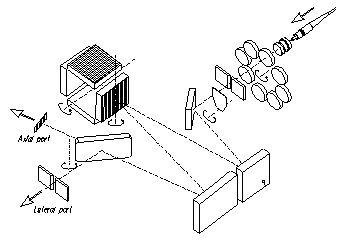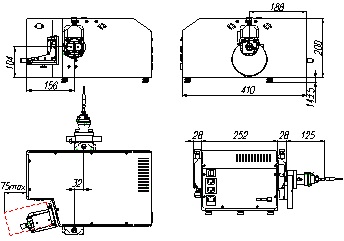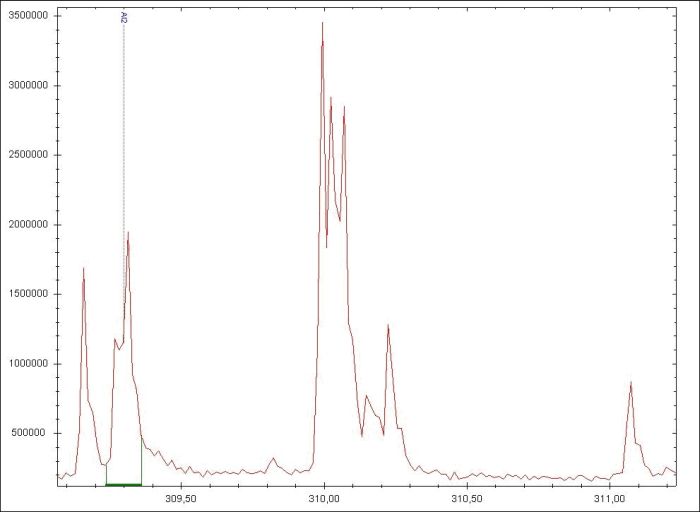M266 Automated Monochromator/Spectrograph is a compact versatile high-aperture instrument featuring high optical quality and low stray light that can be used as a monochromator and/or as a flat field spectrograph. Two output ports allow connecting to M266 two exit slits, exit slit\detector or two detectors simultaneously.
М266 is completely automated. Scanning and changing of diffraction gratings, order separating filters, adjustment of slit width and selection of an output port are performed automatically and controlled via the intelligent and easy-to-use software.
М266 contains the embedded active HUB which provides control over the whole system consisting of the monochromator and detectors, from your personal computer via one USB cable only.
Perfect flat field and intelligent software allow panoramic spectra with multiple scanning and replacement of gratings and filters to be easily acquired and put into your analytical report.. M266 provides wide possibilities for processing and analysis of the spectrum: intensity calibration, automatic search and analysis of peaks, spectra calculator, axonometric spectrum, etc.
The М266i (Imaging version) contains a cylindrical folding mirror and provides astigmatism compensation for both output ports, thus ensuring use of M266 with 2D detectors not only in the binning mode, but also in the mode of obtaining a two-dimensional Image
At your request, M266 Automated Monochromator/Spectrograph is supplied with DLLs and LabVIEW drivers for controlling the instrument via individually designed software.
| Optical scheme |
optimized Czerny-Turner with one input and two outputs |
| Spectral range |
- typical 180 – 3600 nm (see the specifications below),
- up to 40 mkm when the appropriate gratings are used |
| F/Number |
1 : 3.8 |
| Focal length |
284 mm |
| Flat field |
30 x 10 mm |
| Imaging |
Option. Available for both output ports simultaneously |
| Gratings |
50 x 50 x 10 mm, automatically controlled, one or four from the list below 1) |
| - lines/mm1) |
2400 |
1800 |
1200 |
600 |
400 |
300 |
| - reciprocal linear dispersion (average), nm/mm2) |
1.58 |
2.12 |
3.18 |
6.37 |
6.32 |
9.6 |
9.41 |
12.75 |
12.64 |
| - blazing wavelength, nm |
225 |
270 |
400 |
750 |
1000 |
800 |
1700 |
1500 |
2000 |
| - spectral range, nm3) |
180-450 |
180-600 |
265-900 |
500-1500 |
660-1800 |
530-1600 |
1130-2700 |
1000-3000 |
1330-3600 |
| - multichannel array bandpass (average), nm |
384) |
514) |
764) |
1504) |
805) |
2304) |
1205) |
1605) |
1605) |
| - resolution (average), nm |
<0.14)
0.056) |
<0.154)
0.076) |
<0.224)
0.16) |
<0.454)
0.26) |
<0.455)
0.26) |
<0.74)
0.36) |
<0.75) |
<0.945) |
<0.945) |
| Entrance/exit slits |
adjustable with micrometric and automatic drives from 0 to 2 mm, 12 mm height |
| Integrated shutter |
adjusted automatically, serves for measuring dark signal |
| Computer interface |
High Speed USB |
| Dimensions and Weight |
410 х 252 х 213 mm, 23,5 kg | 1) For obtaining spectral parameters differing from the above, diffraction gratings with other lines quantity can be used.
2) Reciprocal linear dispersion is indicated for blazing wavelength
3) Wavelength range for which diffraction efficiency exceeds 40%
4) For detector with 24 mkm pixel size and 24.5 mm length of active area
5) For detector with 25 mkm pixel size and 12.8 mm length of active area
6) For detector with 8 mkm pixel size and 29.1 mm length of active area
 
Fe quadruplet at 310 nm acquired with M266 allows at least 3 peaks to be easily resolved. Fe lines are 309.9897nm, 309.9971nm, 310.0304nm, 310.0666nm. M266 contained 1800 l\mm grating and a linear image sensor with 25 um pixel width.

Available models
M266-I Housing with standard optics, one grating
M266i-I Housing with Imaging optics, one grating
M266-IV Housing with standard optics, 4-gratings turret
M266i-IV Housing with imaging optics, 4-gratings turret
Each model requires standard or crossed input slit, output slit or detector with detector adapter. See these here.
Please select suitable gratings from the above table. Custom gratings available for special order.
Please see this file for detectors of choice. Most common models:
- UC-14T3 (sensor: Toshiba's TCD1304AP)
- UC-14T2 (sensor: Toshiba's TCD1205D)
- UC-14H83 (sensor: Hamamatsu S8378-1024Q)
|
